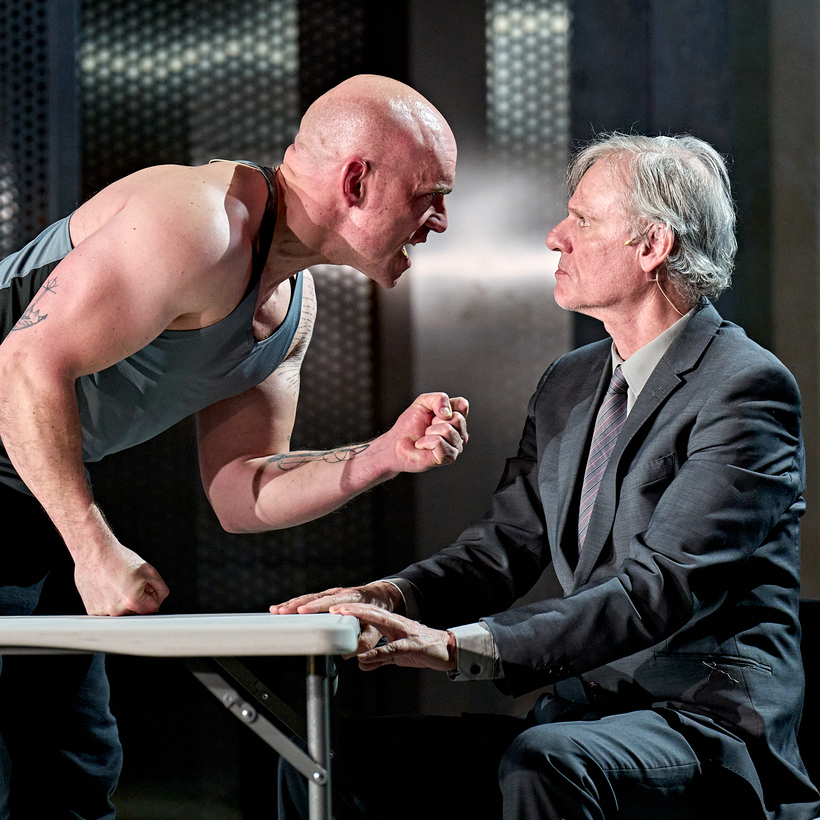Raoul Moat was a 37-year-old steroid-stuffed northern English bodybuilder. At six feet three and nearly 240 pounds, he had all the prerequisites, including a terrible temper, for his job as a Newcastle nightclub bouncer.
On July 1, 2010, after serving 18 months in Durham Prison for assaulting a nine-year-old family relative, Moat was released. Forty-eight hours later, Moat tracked down his former partner, Samantha Stobbart, at her parents’ home in the company of her new boyfriend, Chris Brown, whom she’d acquired while Moat was in jail. When they left the house, Moat was waiting for them in the bushes. He blasted them with his double-barreled shotgun, killing Brown and severely wounding the 22-year-old Stobbart.
“That jail made us unwell. I came out a different kid, you know what I mean?,” Moat wrote in a 17-page letter to the Northumbria police explaining his mayhem. “I lost everything through yous, right? So at the end of the day yous killed me and him before that trigger was ever pulled.” He added: “The public need not fear me but the police should as I won’t stop till I’m dead.”

What followed was the largest manhunt in British history. Around 200 police officers, representing about 10 percent of the available force, combed North East England for seven days until Moat was finally cornered near the picturesque market town of Rothbury.
The tabloids gourmandized on the horror and dubbed him “The Psycho Commando.” On Facebook, a tribute page, “RIP Raoul Moat You Legend,” appeared and generated around 10,000 likes. In Parliament, then prime minister David Cameron decried this public response: “Raoul Moat was a callous murderer—full stop. I cannot understand any wave, however small, of public sympathy for this man.”
Manhunt (at the Royal Court Theatre, in London, until May 3), written and directed by Robert Icke, is a thought-provoking re-examination of Moat’s legendary standoff with the police, based on real events, with dialogue mostly taken from Moat’s letters, texts, and voluminous tape recordings of his desperation. (Andrew Hankinson, the author of the award-winning You Could Do Something Amazing with Your Life [You Are Raoul Moat], is the production’s artistic adviser.) At first glance, Icke’s enterprise seems a volte-face from his slick updating of the classics, especially Greek tragedy—Oedipus, his latest astute adaptation, won this year’s Olivier Award for best revival—but it turns out to be an extension of his ongoing inquiry into tragedy, the caprice of destiny, and free will.
Icke is a generational theatrical director—on par with Nicholas Hytner, Trevor Nunn, and Peter Hall—with an appetite for intellectual derring-do. Here, while the paying customers take their seats, the boldness of his dramatic imagination is already on sensational display. Behind Hildegard Bechtler’s gorgeous gossamer scrim, which is draped over delicate latticework that suggests a cage, Moat (the buff, bellicose Samuel Edward-Cook) paces his cell.
He’s caught up in the hurly-burly of his befuddled mind. He hunkers. He stalks the periphery. He kicks the wall. As Moat patrols his warren, every movement is simultaneously projected onto the scrim but from oblique angles and always slightly out of sync.
In Ash Woodward’s riveting video design, Moat is seen from above, upside down, sideways, close-up. These grainy, ghostly silhouettes read as doppelgängers—usually harbingers of bad luck—that both distort and define him. We are looking literally, and metaphorically, at a split personality. Icke’s narrative game is to externalize an internal world, to humanize Moat, and to contemplate the psychological process that turns a young heart into a dead heart.
For a few minutes, Icke lets the audience stew in Moat’s sulfurous solitude. Then the scrim and lattices rise, and Edward-Cook comes downstage to unload his powerful, frenetic complaint. “I feel tired, anxious, isolated, helpless, angry. I find it difficult to sleep,” he says to an offstage clinician, as if to us. Pain stops thought, and Moat can’t think. He stands before us as a towering palooka of emotional paradox, torn between wanting a future and wanting death. Behind his external hardness is an internal fragility. He’s a dead man walking who inspires pity as well as disgust.
Moat is unmoored and discombobulated, at war with society and himself. He is always braced. He is pleading for psychiatric help but being asked to fill out a 17-page form. “I do not wish to discuss my life with paper. I can express myself better in person,” he says. To a prosecutor at a later court hearing who asks why he wanted to make this hospital application when he subsequently missed two psychiatric appointments, Moat answers, “Someone to talk with us.”
Moat wants to be seen, and heard. He is confounded by the undertow of combustible feelings that keep derailing his life and sinking his every claim to normality as father, husband, and citizen. He’s a whirlwind of self-justification and self-pity. The abusive, violent, quixotic, unbounded man whom police, social workers, and, especially, Stobbart reflect back to him has no purchase on the crazy paving of Moat’s mind. He can broadcast, but he can’t receive.
Icke’s Cubist style of storytelling, the abstract game of hide-and-seek he plays with the audience, requires close attention but slowly traps the underlying lineaments of Moat’s rage, a fury that goes back to the betrayals of the madhouse into which he was born. Moat never knew his father. (“I have not got a dad—no one cares about me” were his last words before he shot himself.) He was incessantly beaten by his stepfather; his bipolar mother, who was mostly hospitalized during his childhood, was alternately violent (locking him in his room, burning his toys) and idealizing him and his half-brother as “princes.”
Stobbart, he said, was “the key to my real life.” In his mind, only she saw him and saved him from himself and his flameouts. “I rely on her to have any normal life,” Moat told the police in a phone call, a transcript of which was printed in The Guardian. “There is always the other side of me that takes over when I’m hurt and only Sam can control it. She can make it go away or bring it back.”

In Icke’s prismatic telling, during a testy telephone call after Moat’s release—he called her 188 times from prison—a chance remark by Stobbart (the steely Sally Messham) ignites his ancient terror of abandonment. Her words push him over the edge and turn his story from psychodrama to tragedy. In the call, as both a warning and a windup, Stobbart taunts Moat about Brown’s strength. “He’ll knock you straight on your fuckin’ arse, Raoul.” Moat knows where Brown teaches karate and threatens a visit to straighten him out.
Stobbart: I’m telling you, you come around here, you come off worse.
Moat: How will I?
Stobbart: He’s a police officer, isn’t he?
Moat: He’s what?
Stobbart: He’s a police officer, he works for Northumbria Police. And he’ll use that, right, if you come up with any trouble. He’ll use the police to get you. Stitch you right up!
That night, after shooting Stobbart and Brown, Moat called the Northumbria Police and declared war. “I’m coming to get you,” he said. The next day, Moat approached a police car parked near a roundabout, knocked on the window, and shot constable David Rathband in the face. In a split second of absurd violence, the policeman’s life was turned upside down. Rathband ultimately lost his sight, his job, his wife, his home, and finally his life. He hanged himself.
“If it hadn’t have been a police officer, I wouldn’t have shot him,” Moat told the Northumbria constabulary after he’d killed Brown and gone on his rampage. The problem was that Brown wasn’t a policeman. The epic of ruination caused by Moat’s killing spree was based on Stobbart’s white lie. Moat’s paranoia about the police was no news to her. Was her misspeaking to warn him off? An unconscious sadistic attack? Or both?
With the inevitable detachment that comes from jumping back and forth in time, Icke’s narrative style demands that an audience work for meaning, not wallow in outrage. Of the many cross-currents of emotional paradox Icke manages to flush out into the open in his well-written dissection of Moat’s uninformed heart—love and hate, surrender and submission, life and death—the most brilliant is the connection between revenge and nostalgia.
Early on in the play, Moat calls himself “a gatherer, a protector, a hunter.” The shooting of Stobbart—an act he later regretted—was a piece of magical thinking, intended to return life to a place that had already been lost. He wanted to maim her, not kill her, he tells the negotiator during the standoff, so she could claim insurance. “A massive compensation for her and the bairn [child] for the future because I’m not going around in a few days. And she’ll have a small scar to remind her: never do this to anyone again,” he says. In his crazed, delusional mind, Icke’s play suggests, the shooting of Stobbart reconnects him to her and to his place in the family: the protector, the provider, the man.
John Lahr is a Columnist at AIR MAIL and the first critic to win a Tony Award, for co-authoring Elaine Stritch at Liberty


